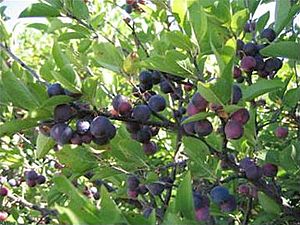Beach plum facts for kids
Quick facts for kids Beach plum |
|
|---|---|
 |
|
| Conservation status | |
| Scientific classification | |
| Genus: |
Prunus
|
| Species: |
maritima
|
| Synonyms | |
|
|
Prunus maritima, the beach plum, is a species of plum native to the East Coast of the United States, from Maine south to Maryland. Although sometimes listed as extending to New Brunswick, the species is not known from collections there, and does not appear in the most authoritative works on the flora of that Canadian province.
Prunus maritima is a deciduous shrub, in its natural sand dune habitat growing 1–2 m (40–80 inches) high, although it can grow larger, up to 4 m (160 inches or over 13 feet) tall, when cultivated in gardens. The leaves are alternate, elliptical, 3–7 cm (1.2–2.8 inches) long and 2–4 cm (0.8–1.6 inches) broad, with a sharply toothed margin. They are green on top and pale below, becoming showy red or orange in the autumn. The flowers are 1–1.5 cm (0.4–0.6 inches) in diameter, with five white petals and large yellow anthers. The fruit is an edible drupe 1.5–2 cm (0.6–0.8 inches) in diameter in the wild plant, red, yellow, blue, or nearly black.
A plant with rounded leaves, of which only a single specimen has ever been found in the wild, has been described as Prunus maritima var. gravesii (Small) G.J.Anderson, though its taxonomic status is questionable, and it may be better considered a cultivar Prunus maritima 'Gravesii'. The original plant, found in Connecticut, died in the wild in about 2000, but it is maintained in cultivation from rooted cuttings.
The plant is salt-tolerant and cold-hardy. It prefers the full sun and well-drained soil. It spreads roots by putting out suckers but in coarse soil puts down a tap root. In dunes it is often partly buried in drifting sand. It blooms in mid-May and June. The fruit ripens in August and early September.
The species is endangered in Maine, where it is in serious decline due to commercial development of its beach habitats.
Contents
Cultivation and uses
The species is grown commercially to make jam. Although it is bitter or sour it can be eaten out of hand. Beach plums are much smaller in size when compared to the longer cultivated Asian varieties found in the supermarket. A number of cultivars have been selected for larger and better flavored fruit, including Resigno, Eastham, Hancock and Squibnocket.
Natali Vineyards in Goshen, New Jersey produces a wine from beach plums. Greenhook Ginsmiths in Greenpoint, Brooklyn, New York makes a gin flavored with beach plums.
Nomenclature
The species was first described by Marshall in 1785 as Prunus maritima, the "Sea side Plumb". A few sources cite Wangenheim as the author, though Wangenheim's publication dates to 1787, two years later than Marshall's.
Plum Island, Massachusetts, and Plum Island, New York, are named after the beach plum; as are Plum Cove Beach in Lanesville, Gloucester, Massachusetts; and Beach Plum Island State Park in Sussex County, Delaware.
Gallery
See also
 In Spanish: Prunus maritima para niños
In Spanish: Prunus maritima para niños






